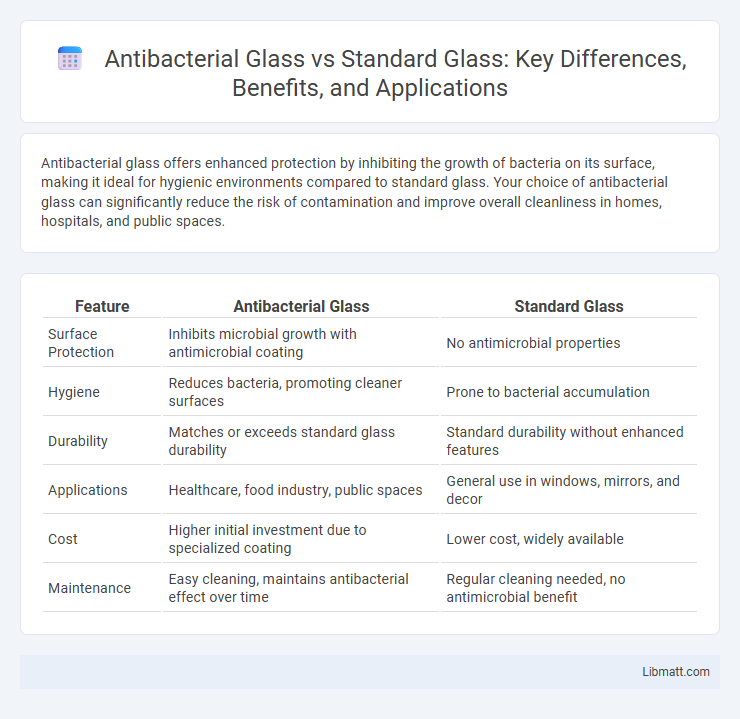Antibacterial glass offers enhanced protection by inhibiting the growth of bacteria on its surface, making it ideal for hygienic environments compared to standard glass. Your choice of antibacterial glass can significantly reduce the risk of contamination and improve overall cleanliness in homes, hospitals, and public spaces.
Table of Comparison
| Feature | Antibacterial Glass | Standard Glass |
|---|---|---|
| Surface Protection | Inhibits microbial growth with antimicrobial coating | No antimicrobial properties |
| Hygiene | Reduces bacteria, promoting cleaner surfaces | Prone to bacterial accumulation |
| Durability | Matches or exceeds standard glass durability | Standard durability without enhanced features |
| Applications | Healthcare, food industry, public spaces | General use in windows, mirrors, and decor |
| Cost | Higher initial investment due to specialized coating | Lower cost, widely available |
| Maintenance | Easy cleaning, maintains antibacterial effect over time | Regular cleaning needed, no antimicrobial benefit |
Introduction to Antibacterial Glass and Standard Glass
Antibacterial glass incorporates antimicrobial agents like silver ions to inhibit bacterial growth on its surface, offering enhanced hygiene compared to standard glass. Standard glass is made primarily of silica and lacks any inherent properties to prevent microbial contamination. Choosing antibacterial glass can improve cleanliness in environments where reducing bacterial presence is critical for your health and safety.
How Antibacterial Glass Works
Antibacterial glass is engineered with a special coating containing antimicrobial agents such as silver ions that disrupt the cell membranes of bacteria, preventing their growth and reproduction on the surface. Unlike standard glass, which allows bacteria to accumulate and potentially spread, antibacterial glass actively reduces microbial contamination, ensuring a cleaner and safer contact surface. Your environment benefits from this technology by minimizing the risk of bacterial transmission, particularly in high-touch areas.
Key Features of Standard Glass
Standard glass is a versatile material characterized by its transparency, durability, and resistance to heat and chemicals, making it suitable for windows, containers, and screens. It lacks antimicrobial properties, allowing bacteria and microbes to accumulate on its surface over time. Your choice of glass should consider these features when hygiene and cleanliness are critical factors.
Comparative Analysis: Surface Cleanliness
Antibacterial glass features a specialized coating that inhibits bacterial growth, resulting in significantly higher surface cleanliness compared to standard glass, which allows microbes to accumulate over time. Studies show that antibacterial glass reduces bacterial presence by up to 99%, maintaining a more hygienic environment and decreasing the risk of contamination. Your choice of antibacterial glass ensures enhanced protection in settings where cleanliness is critical, such as healthcare or food-related industries.
Impact on Health and Hygiene
Antibacterial glass significantly reduces the presence of harmful bacteria and pathogens on surfaces, contributing to improved health and hygiene by minimizing the risk of cross-contamination and infections. Unlike standard glass, which can harbor microbes for extended periods, antibacterial glass incorporates antimicrobial agents that actively inhibit microbial growth. This feature is especially crucial in healthcare facilities, food processing environments, and public spaces where maintaining a sterile environment is essential for preventing disease transmission.
Durability and Maintenance Requirements
Antibacterial glass offers enhanced durability due to its specialized coating that resists microbial degradation and surface scratches better than standard glass, maintaining clarity and structural integrity over time. Its maintenance requirements are reduced as the antimicrobial surface inhibits bacterial buildup, minimizing the need for frequent cleaning and harsh chemicals. Standard glass tends to accumulate bacteria and requires more rigorous cleaning regimens to preserve hygiene and appearance.
Cost Differences and Economic Considerations
Antibacterial glass typically incurs higher initial costs than standard glass due to specialized coatings or embedded antimicrobial agents, influencing budget allocations for projects requiring enhanced hygiene. Long-term economic considerations include potential savings on cleaning and maintenance, as antibacterial properties can reduce microbial buildup and associated cleaning frequencies. Decision-makers must weigh upfront investment against durability benefits and health-related cost reductions in environments like healthcare facilities or food processing units.
Applications: Where Each Type Excels
Antibacterial glass excels in healthcare environments, food packaging, and public touchpoints due to its ability to inhibit microbial growth, enhancing hygiene and safety. Standard glass is widely used in construction, automotive, and decorative applications where antimicrobial properties are not critical but clarity, durability, and cost-effectiveness are prioritized. Choosing between antibacterial and standard glass depends on specific use cases requiring enhanced sanitation versus general structural or aesthetic needs.
Environmental Impact and Sustainability
Antibacterial glass often incorporates special coatings or additives that can impact its recyclability compared to standard glass, which is fully recyclable and abundant in recycling facilities, thus promoting sustainable waste management. The production of antibacterial glass may involve additional energy and resources, potentially increasing its environmental footprint relative to standard glass. Choosing antibacterial glass balances enhanced hygiene benefits against these environmental considerations, making it essential to evaluate Your sustainability priorities.
Making the Right Choice: Factors to Consider
Antibacterial glass offers enhanced protection by inhibiting microbial growth, making it ideal for healthcare settings and high-touch surfaces, while standard glass provides basic durability and clarity at a lower cost. When making the right choice, consider factors such as hygiene requirements, maintenance frequency, budget constraints, and intended usage environment. Your decision should balance antimicrobial benefits with practical needs to ensure optimal safety and functionality.
antibacterial glass vs standard glass Infographic

 libmatt.com
libmatt.com